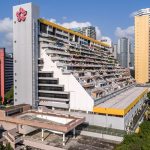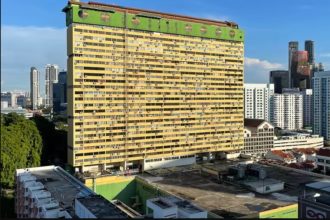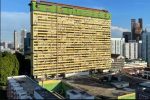Key takeaway
Old Changi Hospital is often called Singapore’s most haunted building. Built in 1935 by the British as a Royal Air Force hospital, it has a dark and complex history, from treating POWs in World War II to serving the Singapore Armed Forces. Since its closure in 1997, its abandoned corridors have inspired ghost stories, films, and even redevelopment proposals. The haunting is as much about memory and history as about the supernatural.
At the end of a quiet road in eastern Singapore sits Old Changi Hospital, an abandoned, weathered complex of colonial buildings that many believe is haunted. With peeling white walls, creeper-laced windows, and a reputation for ghostly activity, the hospital draws intrigue and dread in equal measure. But why is this British-built building so infamous? Let’s look beyond the folklore and into the real story behind one of Singapore’s most haunted places.
History of Old Changi Hospital: From RAF Base to Abandoned Facility
Old Changi Hospital occupies three main buildings at Halton Road: Blocks 24, 37, and 161. Blocks 24 and 37 date back to the 1930s and were originally part of a British military base. Block 161 was added in the 1960s. The architectural style is colonial bungalow with reinforced concrete, a design that lends an eerie stillness to its current derelict state.
In 1935, the Royal Air Force (RAF) officially commissioned the hospital to serve British military units stationed in Changi, such as the Royal Engineers, Artillery, and other regiments. The hospital included wards, X-ray rooms, operating theatres, dental facilities, and a maternity wing. During the Second World War, the site was pressed into service under Japanese occupation to treat Allied prisoners of war, though many accounts also suggest darker uses.
After the war, control shifted among different military groups. The hospital became ANZUK Hospital (serving Australian, New Zealand, and UK forces), then UK Military Hospital, and later the Singapore Armed Forces (SAF) Hospital. By 1976, it merged with Changi Chalet Hospital, forming Changi Hospital under Singapore’s Ministry of Health. Finally, on 15 December 1997, it closed when operations moved to Changi General Hospital in Simei. Ownership passed to the Singapore Land Authority (SLA), and security measures were eventually installed to prevent trespassing.
Why People Call Old Changi Hospital “Haunted”
The hospital’s haunted reputation is tied to many stories. One of the most persistent is that during the Japanese occupation, it was used as a torture facility by the Kempeitai, the Japanese military police. There are tales of prisoners being impaled on stakes, though solid historical records do not clearly support these claims.
Paranormal enthusiasts report:
- Sightings of apparitions in colonial-era uniforms or hospital attire.
- Shadow people moving through windows.
- Whispers, screams, footsteps, and even phantom hands.
- A ghostly young boy who quietly sits and watches.
Some of these stories gained more attention with the 2010 horror film Haunted Changi, a found-footage film shot on location. A similar sense of abandonment and misfortune was seen at the abandoned royal palace, which survived two fires and a war.
The Role of Urban Myth and Media
Part of the building’s haunted status comes from its slowly decaying structure. Since its closure, the hospital has been used by filmmakers and for television shoots. The Singapore Land Authority rented the site out, and several dramas used it as a backdrop; its colonial architecture and overgrown grounds offered a perfect, eerie set.
Visitors and urban explorers have compared it to other abandoned sites in Singapore, like the failed theme park, noting how unused structures often acquire stories and legends over time.
Dark History vs. Ghost Stories: Separating Fact from Fiction
When we ask whether Old Changi Hospital is really haunted, the answer is complicated. The building certainly carries a heavy historical weight, but many of the more sensational ghost stories don’t line up with documented records.
What the Records Say
Historical accounts confirm that the hospital treated Allied POWs during World War II, but reliable evidence for mass torture or Kempeitai executions is weak. After the war, it continued to operate normally, serving military and civilian patients for decades.
The Singapore Land Authority and Urban Redevelopment Authority (URA) recognize its heritage value. In 2021, they ran a design competition to repurpose the site while preserving its character. The winning proposal suggests converting it into a nature-inspired observatory with boardwalks and viewing decks.
A Snapshot of Old Changi Hospital
| Building | Key facts | Current status | Sources |
|---|---|---|---|
| Old Changi Hospital (Blocks 24, 37, 161) | Built in 1935 by the British, served the RAF and POWs, later the SAF Hospital, and was closed in 1997 | Vacant, fenced, with redevelopment proposals (e.g., stargazing observatory) | Roots |
Top 3 Reasons the Haunting Myth Persists
Old Changi Hospital’s reputation as Singapore’s most haunted building is not just a product of imagination. Several factors combine to keep the ghost stories alive, drawing curiosity seekers and paranormal enthusiasts alike.
- Historical trauma: The hospital’s past during World War II, when it treated Allied prisoners of war under harsh conditions, creates a natural sense of unease. Stories of suffering, fear, and survival during those years make the idea of lingering spirits feel plausible, even for skeptics. Visitors often sense the weight of history in its empty corridors, which adds a layer of authenticity to the haunting narrative.
- Atmospheric decay: Years of abandonment have left the buildings in various stages of decay. Peeling paint, broken windows, overgrown vines, and rusting equipment contribute to an eerie, otherworldly atmosphere. The visual effect of empty wards and dark hallways amplifies feelings of isolation and dread, making even the most mundane sounds seem supernatural to those exploring the site.
- Media amplification: Films, social media posts, and ghost tours have all helped cement the hospital’s haunted status. Movies like Haunted Changi and viral exploration videos present the building as a site of paranormal activity. Local folklore shared online, along with guided tours that emphasize ghost stories, encourages visitors to interpret ordinary events as paranormal, reinforcing the myth for a wider audience.
What the Future Might Hold for Old Changi Hospital
Although the hospital remains largely untouched, planners are slowly shaping its future. Various redevelopment proposals aim to preserve Old Changi Hospital’s historical and architectural significance while giving the site a renewed purpose. The URA–SLA design competition generated ideas that balance conservation with public engagement, recommending uses such as small cafés, shaded walking trails, and elevated observation decks so visitors can explore the grounds safely.
Other proposals include heritage tours, stargazing platforms, and interactive displays that showcase the building’s layered history, from its RAF origins to its wartime role and eventual closure. These plans create spaces where the public can appreciate both the architectural details and the stories embedded in the hospital’s walls. The competition results, detailed in redevelopment proposals for Old Changi, guide efforts to preserve the structure while giving it a meaningful role for the community.
The Haunting Is as Much History as Mystery
Does Old Changi Hospital truly host spirits? The answer extends beyond ghost stories. People continue to regard the building as haunted because it combines historical weight with an eerie atmosphere. Every peeling wall reminds visitors of decades of human experience. Shadowed hallways and rusted stairwells evoke memories of wartime trauma, medical care, military occupation, and eventual abandonment.
Some tales of apparitions and strange sounds exaggerate reality or reflect imagination, yet the site carries deeper significance. Memory itself lingers in Old Changi Hospital—the struggles, resilience, and everyday lives of those who passed through its doors. In many ways, the haunting resides not just in spectral legends but also in the questions it raises about preservation and respect. It challenges how society treats its historical spaces. Visitors and heritage enthusiasts confront the building to reflect on the past. They also imagine what the future might hold for this British-built relic.








